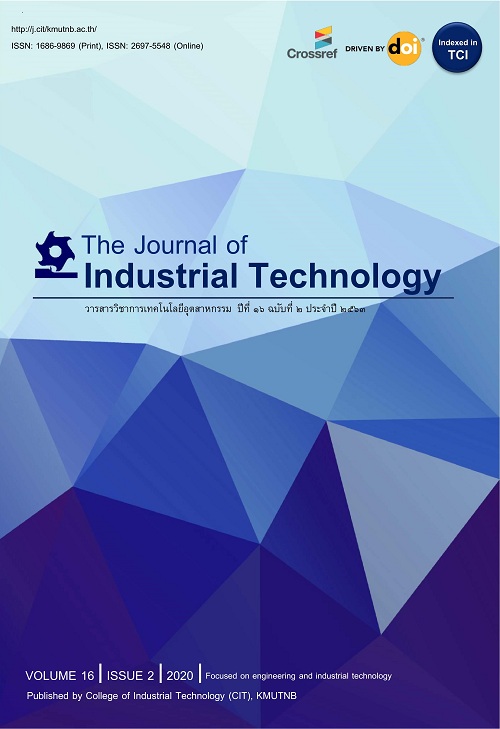Research and Development of a Dual-Fuel Radiant Burner for Diverse Applications: Utilizing of Liquefied Petroleum Gas and Bio-Ethanol
การวิจัยและพัฒนาเตาแผ่รังสีเชื้อเพลิงคู่ก๊าซแอลพีจีและไบโอเอทานอลเพื่อการใช้งานเอนกประสงค์
Abstract
บทความนี้คือการพัฒนาและทดสอบสมรรถนะเตาหุงต้มเชื้อเพลิงคู่ก๊าซแอลพีจีและไบโอเอทานอลเพื่อการประกอบอาหารและใช้งานอเนกประสงค์ในครัวเรือนและร้านอาหาร มีจุดมุ่งหมายเพื่อลดการพึ่งพาเชื้อเพลิงฟอสซิลที่การเผาไหม้ทำให้เกิดการปลดปล่อยก๊าซเรือนกระจกที่ส่งผลกระทบต่อสภาวะโลกร้อนไบโอเอทานอลเป็นเชื้อเพลิงหมุนเวียนที่มีศักยภาพสูงในการใช้เป็นเชื้อเพลิงสำหรับเตาหุงต้มทดแทนก๊าซแอลพีจี เนื่องจากเอทานอลสามารถผลิตได้เองในประเทศจากพืชผลทางการเกษตรจึงให้การปลดปล่อยคาร์บอนสุทธิเป็นศูนย์ เตาแผ่รังสีเชื้อเพลิงคู่นี้ หัวเผาประกอบด้วยโฟมเซรามิกที่ทำจากซิลิกอนคาร์ไบด์ มีความพรุนสูงและมีน้ำหนักเบา มีหัวฉีดร่วมเพียงตัวเดียวสำหรับการจ่ายเชื้อเพลิงสองชนิด การส่งเสริมการหมุนเวียนความร้อนภายในหัวเผาวัสดุพรุนส่งผลให้เตาสามารถทำงานได้อย่างมีเสถียรภาพได้ทั้งการเผาไหม้ก๊าซแอลพีจีและไบโอเอทานอลที่มีค่าความร้อนต่ำ อุณหภูมิการเผาไหม้จะเพิ่มขึ้นตามอัตราการป้อนความร้อนที่เพิ่มขึ้น การเพิ่มอากาศปฐมภูมิมีผลดีต่อการเผาไหม้ก๊าซแอลพีจีให้การปล่อยก๊าซคาร์บอนมอนนอกไซด์ (CO) ลดลง แต่มีผลตรงกันข้ามกับการเผาไหม้เอทานอลที่ CO กลับเพิ่มขึ้นเมื่ออากาศปฐมภูมิเพิ่มขึ้น การเผาไหม้ก๊าซแอลพีจีมีการปลดปล่อยมลภาวะที่น้อยกว่าการเผาไหม้ไบโอเอทานอลที่ทุกอัตราส่วนสมมูล รวมถึงก๊าซแอลพีจีมีช่วงการทำงานที่กว้างกว่าไบโอเอทานอล สภาวะการทำงานที่เหมาะสมที่สุดสำหรับการเผาไหม้ไบโอเอทานอลของหัวเผาที่พัฒนาขึ้นนี้ คือที่อัตราการป้อนเชื้อเพลิง 5.50 กิโลวัตต์ ซึ่งมีอุณหภูมิสูงสุดใกล้เคียงกับการเผาไหม้ก๊าซแอลพีจี
In this article, a dual-fuel radiant burner was developed and tested for home and restaurant cooking. It uses liquefied petroleum gas (LPG) and bioethanol with the aim of reducing reliance on fossil fuels, a primary source of greenhouse gas emissions. Bioethanol, as a renewable fuel, shows great promise in replacing LPG. It results in net zero carbon emissions because it can be domestically produced from agricultural waste and products. The burner head comprises lightweight, highly porous ceramic foam made of silicon carbide and incorporates a single conventional gas injector for supplying both fuels. The results showed that the burner provided relatively high stable combustion of both LPG and bioethanol with low calorific value. This is due to the advantage of internal heat circulation of combustion within a porous medium burner. The combustion temperature increases with the firing rate. Increasing primary air has a positive effect on LPG combustion, leading to reduced carbon monoxide (CO) emissions. However, it has the opposite effect on bioethanol combustion, resulting in increased CO emissions with higher primary air entrainments. Firing LPG yields higher combustion efficiency compared to bioethanol. Nevertheless, at a firing rate of 5.50 kW of bioethanol, the maximum temperature reached is similar to that of LPG at the same firing rate, representing the optimal condition for this developed burner using bioethanol as fuel.
Keywords
[1] http://www.eppo.go.th/images/Energy-Statistics/energyinformation/Energy_Statistics/00All.pdf. (Accessed on 1 June 2023)
[2] https://www.dede.go.th/more_news.php?cid=81&filename=index. (Accessed on 20 June 2023)
[3] F.J. Weinberg; Heat-recirculating burners: principles and some recent developments, Combustion Science and Technology, 1986, 121, 3-22.
[4] S.B. Sathe; M.R. Kulkarni, R.E. Peck and T.W. Tong, An experimental and theoretical study of porous radiant burner performance, Symposium (International) on Combustion, 1991, 1011-1018.
[5] S.A. Lloyd, and F.J. Weinberg, A burner for mixtures of very low heat content, Nature, 1974, 251, 47-49.
[6] H. Gao, Y. Wang, S. Zong, Y. Ma, and C. Zhang, Experimental investigation of a self-sustained liquid fuel burner using inert porous media, Energies, 2023, 16, 5564.
[7] G.S. Sinha, P. Muthukumar, Journal of Physics: Conference Series, 2019, 1240, 012136.
[8] M. Toledo, F. Gonzalez, J. Ellzey, Hydrogen production from methanol and ethanol partial oxidation, Energy Fuels, 2014, 28(5), 3453-3459.
[9] A. Chaelek, U.M. Grare, and S. Jugjai, Self-aspirating/air-preheating porous medium gas burner, Applied Thermal Engineering, 2019, 153, 181-189.
[10] R. Pritchard, J.J. Guy and N.E. Connor, Handbook of industrial gas utilization: engineering principles and practice, Van Nostrand Reinhold Co., NY, USA, 1977.
[11] A. Namkhat and S. Jugjai, Primary air entrainment characteristics for a self-aspirating burner, Model and Experiments, 2010, 35(4), 1701–1708.
[12] TIS 2312-2549, Standard specification for domestic gas stoves for using liquefied fuel, 2006. (in Thai).
[13] EN 203-1:1992, European committee for standardization. Specification for gas heated catering equipment- Part 1: Safety requirements, 1992.
[14] J. X. Zhou, B. Moreau, C. Mounaïm-Rousselle and F. Foucher, Oil and Gas Science and Technology, Revue d'IFP Energies Nouvelles, 2016, 71, 49.
[15] S. Jugjai, Combustion, Chulalongkorn University Press, Bangkok, Thailand, 2004. (in Thai).
DOI: 10.14416/j.ind.tech.2024.08.005
Refbacks
- There are currently no refbacks.






